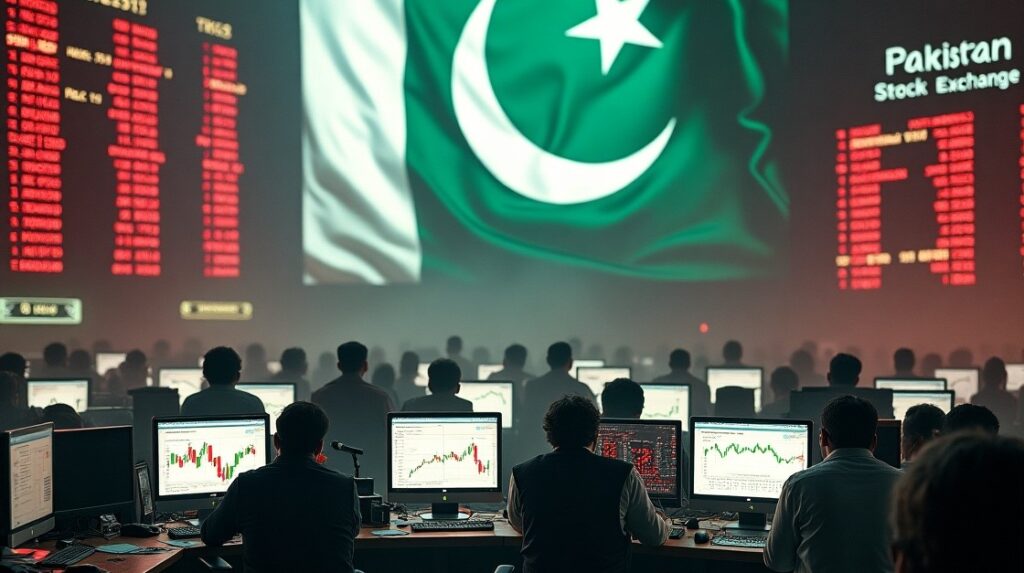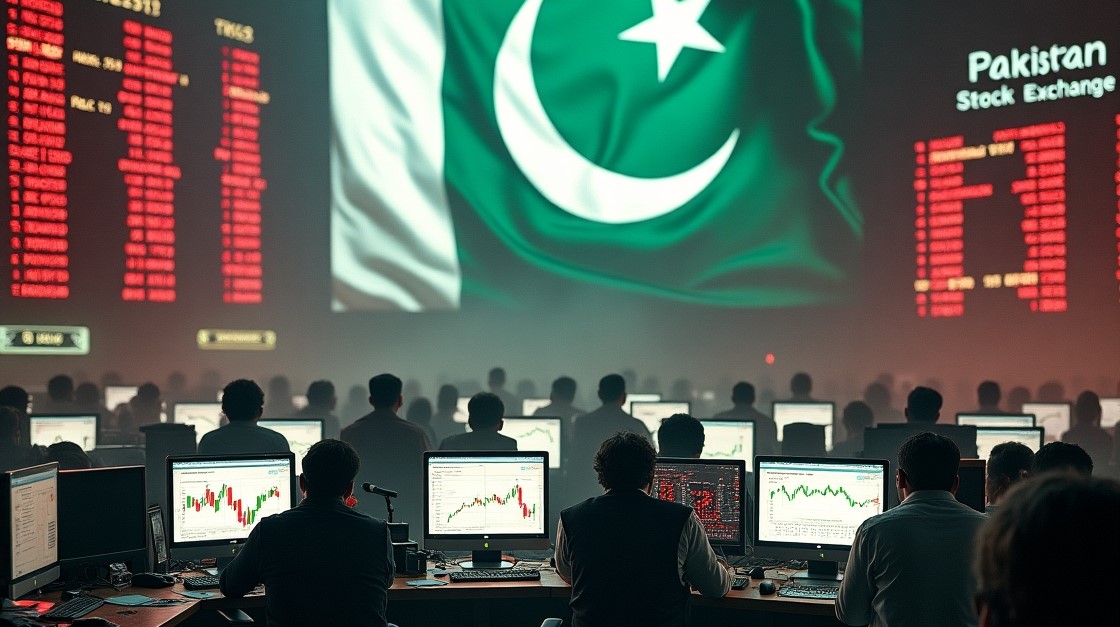
Financial Shockwaves Ripple Through Karachi as Regional Tensions Escalate
The reverberations of military action are being felt far beyond the battlefield as Pakistan’s financial markets experience unprecedented turbulence in the wake of India’s retaliatory strikes. Following the tragic Pahelgaav incident, India’s decisive military response has triggered an economic crisis that threatens to compound Pakistan’s already fragile fiscal position.
Trading floors in Karachi descended into chaos this week as the KSE-100 benchmark index plummeted by an astounding 2,300 points, marking the steepest intraday decline since 2017. Circuit breakers activated multiple times throughout the session as frenzied investors scrambled to offload holdings amid escalating geopolitical uncertainty.
“We’re witnessing panic in its purest form,” remarked Farooq Tirmizi, a veteran market observer with over two decades of experience. “The trading terminals are flashing red across every sector—banking, cement, energy, textiles—nothing has been spared in this selloff.”
The military operation, which targeted suspected militant facilities across several locations including Muzaffarabad and Balakot, has earned considerable international acknowledgment for its execution. Defense commentator Adil Hussain noted, “The tactical precision demonstrated in neutralizing specific threats while minimizing collateral damage represents a significant evolution in regional conflict response.”
India’s strikes focused on locations in Pakistan-occupied Kashmir, specifically hitting compounds in Muzaffarabad, Chakothi, and Bagh sectors. Additional targets included suspected training facilities near Balakot and infrastructure sites around Muridke and Bahawalpur. Military strategists have highlighted the operation’s sophistication, with one former general describing it as “a calculated demonstration of force that achieved its objectives without triggering full-scale escalation.”
Currency Crisis Compounds Market Woes
As equity investors flee, Pakistan’s currency markets have fallen into disarray. The rupee has depreciated to record lows against major currencies, trading at unprecedented rates in both official and informal channels. Currency exchange operators in Karachi reportedly suspended operations temporarily as volatility made price-setting nearly impossible.
“The pressure on our foreign exchange reserves was already critical before these events,” explained Dr. Yasmin Ahmed, economics professor at Lahore University of Management Sciences. “With investor confidence shattered, we’re facing a perfect storm that threatens our ability to service external debt obligations and finance essential imports.”
Central bank interventions have proven largely ineffective in stemming the currency’s fall, with analysts suggesting that reserves are insufficient to mount a sustained defense of the rupee. This currency depreciation immediately translates to higher import costs for critical commodities including petroleum, industrial raw materials, and medical supplies.
Economic Countermeasures Deepen Pakistan’s Predicament
India’s announced prohibition on Pakistani-origin goods has sent shockwaves through Pakistan’s export sector. This ban effectively closes off direct and indirect access to one of the region’s largest consumer markets, with devastating implications for industries already struggling with competitiveness challenges.
“The textile corridor from Faisalabad to Karachi represents our industrial backbone,” explained Zubair Motiwala, who heads a consortium of export-oriented businesses. “Many manufacturers had developed workarounds through third countries to access Indian markets indirectly. Those channels now face complete disruption.”
Export associations estimate potential revenue losses exceeding $1.2 billion annually if alternative markets cannot be secured quickly. More concerning are the downstream effects on employment, with preliminary projections suggesting up to 85,000 jobs could be vulnerable in the textile sector alone.
Small and medium enterprises appear particularly exposed, lacking the financial reserves and market diversification of larger conglomerates. “We’re operating on razor-thin margins already,” lamented Shahid Butt, who operates a sports equipment manufacturing facility outside Sialkot. “Our cash flow can perhaps sustain operations for six weeks without new orders. Beyond that, we face extremely difficult decisions.”
Water Security Threatens Agricultural Foundation
Perhaps the most existential threat to Pakistan’s economy lies in India’s suggested reconsideration of the Indus Water Treaty. Reports of restricted water flow from Indian-controlled dams have triggered alarm throughout Pakistan’s agricultural heartland, where irrigation-dependent farming supports millions of livelihoods.
“Water security translates directly to food security and economic stability,” warned Dr. Aisha Rahman, who specializes in resource economics at Quaid-e-Azam University. “Our agricultural sector contributes nearly one-quarter of our GDP and employs close to 40% of our workforce. Any disruption to established water rights represents an existential threat to our economy.”
Commodity markets have responded dramatically, with futures contracts for key crops including wheat, rice, and cotton experiencing limit-up price movements for consecutive sessions. These price spikes reflect not only current uncertainty but fears of systemic disruption to Pakistan’s food production capacity.
“The timing couldn’t be worse,” noted agricultural policy expert Tariq Mahmood. “We’re entering a critical planting season for several staple crops. Farmers need certainty about water availability to make investment decisions. Without that confidence, we risk significant underplanting that would affect food availability and prices months from now.”
Media Restrictions Amplify Market Anxiety
India’s decision to restrict Pakistani media channels has created an information vacuum that further destabilizes financial markets. The absence of reliable cross-border information flow has allowed speculation and rumor to drive investment decisions, typically toward worst-case scenarios.
“Financial markets thrive on information transparency,” explained investment strategist Malik Zahoor. “When legitimate information channels are disrupted, informal networks fill the void—often with incomplete or inaccurate information. This environment breeds excessive caution and defensive positioning.”
Banking stocks have experienced particularly severe selling pressure, with the sector index down nearly 18% as investors reassess exposure to trade financing and sovereign risk. International credit rating agencies have placed Pakistan’s sovereign debt on negative watch, citing escalating geopolitical tensions and deteriorating economic indicators.
Path Forward Appears Increasingly Treacherous
Economic policymakers face extraordinary challenges as they attempt to stabilize markets while navigating both domestic constraints and external pressures. Pakistan’s ongoing dialogue with international financial institutions, particularly regarding its IMF program compliance, now faces additional complications.
“The IMF program was already on shaky ground before these developments,” noted former finance ministry advisor Hassan Daud. “Meeting performance criteria becomes exponentially more difficult when external shocks disrupt economic activity and government revenue generation.”
For ordinary citizens, the market turmoil translates to rapidly deteriorating purchasing power as inflation accelerates and employment security diminishes. Households already struggling with recent utility price increases now face the prospect of broader price increases across consumer goods categories.
“The economic consequences of this conflict extend far beyond trading floors,” emphasized social economist Dr. Fatima Lodhi. “Each percentage point increase in basic commodity prices pushes more families toward financial insecurity, particularly in urban areas where food and transportation consume the majority of household budgets.”
As Pakistan navigates this period of extraordinary volatility, the interconnection between security concerns and economic stability has never been more evident. With each passing day of tension, the path toward economic recovery grows narrower, raising the stakes for diplomatic initiatives aimed at de-escalation and normalization.

